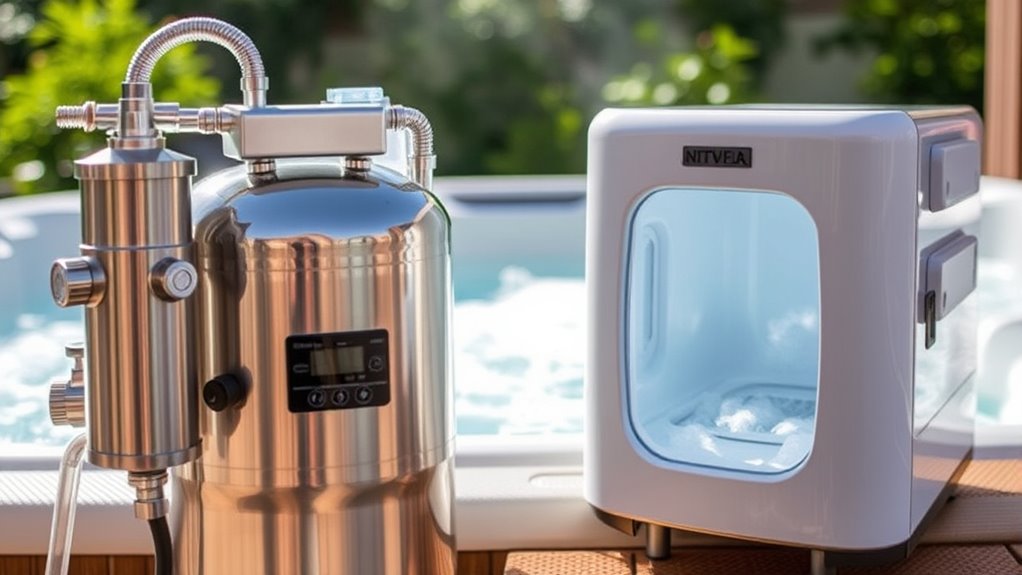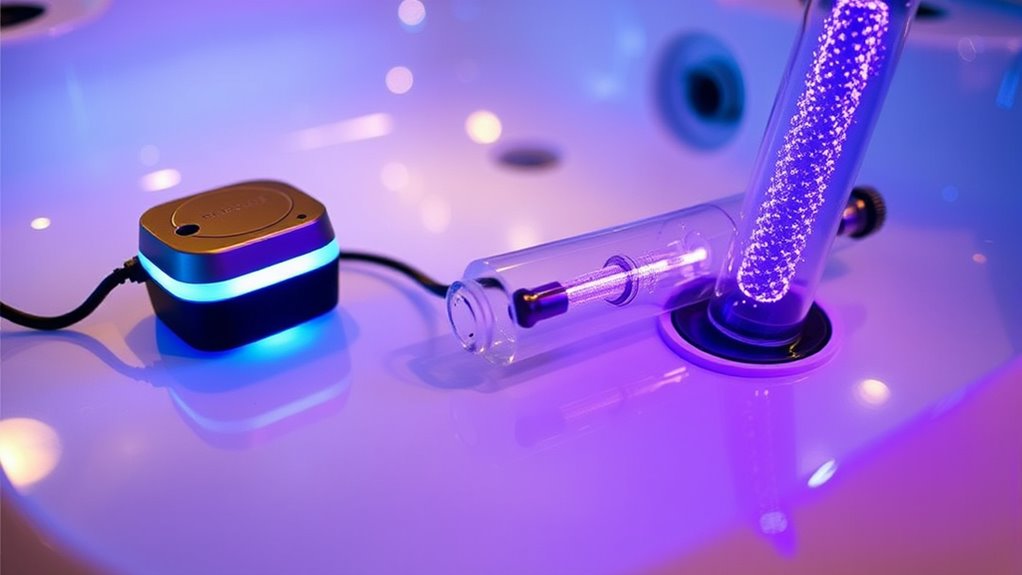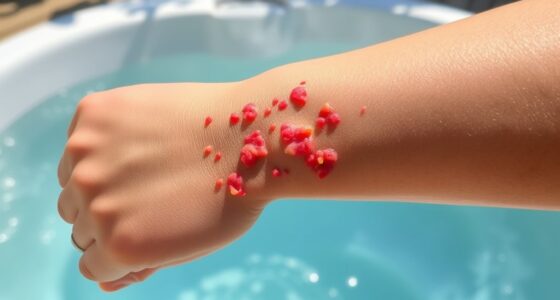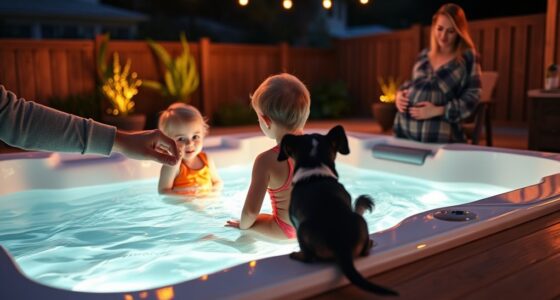If you’re choosing between an ozonator and UV for hot tub sanitation, consider how each works. Ozonators produce ozone to oxidize and neutralize microbes, offering broad-spectrum, rapid cleaning, but require cell replacements and proper ventilation. UV systems use UV light to damage microorganism DNA, providing chemical-free, low-maintenance disinfection with longer-lasting bulbs. Both options have cost differences and environmental impacts. To find out which suits your needs best, explore the details below.
Key Takeaways
- Ozonators disinfect water by oxidizing contaminants and microorganisms, offering broad-spectrum sanitation with potential residuals if not properly ventilated.
- UV systems inactivate pathogens instantly using UV-C light without chemical byproducts, requiring high water clarity for optimal effectiveness.
- Ozonators typically have higher upfront costs but longer-lasting ozone cells, whereas UV systems have lower initial costs but need regular bulb replacements.
- UV systems are low-maintenance, with simple bulb replacement every 12-18 months, while ozonators need ongoing attention to ozone cell performance.
- Both methods reduce chemical use and environmental impact; choose based on budget, maintenance preference, and water quality conditions.
How Ozonators Work to Sanitize Hot Water

Ozonators work by producing ozone gas, a powerful disinfectant that effectively kills bacteria, viruses, and other contaminants in hot water. When activated, the ozonator releases ozone molecules into the water, where they rapidly oxidize organic matter and neutralize pathogens. This process destroys the cell walls of bacteria and viruses, rendering them harmless and preventing their spread. Ozone is highly reactive, so it quickly breaks down contaminants, leaving the water cleaner and safer. Unlike traditional chlorine or bromine treatments, ozone doesn’t leave behind harmful residues or strong chemical odors. It also reduces the need for large amounts of chemical sanitizer, making your hot tub safer and more environmentally friendly. Regular ozone injection keeps your hot water fresh, clear, and hygienic without harsh chemical additives.
The Functionality of UV Systems in Hot Tubs

UV systems use ultraviolet light to disinfect your hot tub water quickly and effectively. They eliminate a wide range of microorganisms, ensuring safer, cleaner water with minimal effort. Maintenance is straightforward, making UV systems a convenient option for keeping your hot tub sanitized. Additionally, UV technology is recognized for its high efficiency in water treatment processes, providing reliable disinfection without the use of chemicals. This method also reduces chemical usage, making it an environmentally friendly choice for hot tub owners.
UV Light Disinfection Process
UV light disinfection works by exposing water in your hot tub to ultraviolet rays, which actively destroy algae, bacteria, and viruses. When water passes through the UV chamber, the rays penetrate microorganisms’ cells, damaging their DNA and rendering them unable to reproduce or cause infection. This process is quick and efficient, providing immediate disinfection without adding chemicals to your water. As the UV light interacts with the water, it targets pathogens directly, reducing their presence and helping to keep your hot tub cleaner. The system operates continuously, so as long as water flows through the UV chamber, microorganisms are exposed and neutralized. This method offers a chemical-free approach, making it a safe, eco-friendly choice for maintaining water purity. Additionally, understanding industry trends can help you choose the most effective sanitizing system for your needs. Incorporating UV systems can also complement other water treatment methods to enhance overall water quality and safety. Modern UV systems are also designed with noise reduction technology, ensuring quiet operation during use. Furthermore, employing UV disinfection can contribute to resilience in your water management strategy by reducing reliance on chemical disinfectants. Moreover, advances in automation technology are making UV systems easier to operate and maintain, providing added convenience for users.
Microorganism Elimination Efficiency
UV systems are highly effective at eliminating a wide range of microorganisms in hot tub water. They work by exposing microbes to powerful UV-C light, disrupting their DNA and rendering them unable to reproduce or cause infection. This rapid sterilization process ensures bacteria, viruses, and protozoa are quickly neutralized, markedly reducing the risk of illnesses. UV systems are especially good at targeting common waterborne pathogens like E. coli, Giardia, and Cryptosporidium. Their efficiency depends on water flow rate, UV dosage, and contact time, but generally, they provide a high kill rate. Unlike chemical disinfectants, UV light leaves no residuals in the water, making it a clean and effective method for maintaining safe, clear hot tub water. Additionally, regular maintenance and proper installation are essential to maximize their performance and lifespan.
Maintenance and Operation Ease
Because they are designed for simplicity, UV systems are generally easy to operate and maintain in hot tubs. You don’t need to handle chemicals or worry about complex adjustments. Once installed, the system runs automatically, turning on when the heater is active. Replacing the UV bulb is straightforward and typically required only once a year. Unlike ozonators, UV units don’t produce ongoing emissions, so there’s less cleaning or maintenance involved. You’ll appreciate the quiet operation and minimal fuss, making it easy to keep your hot tub sanitized without extra effort. Additionally, UV sanitization is a popular choice in Volkswagen Tuning, where simplicity and reliability are valued. The use of natural materials and minimalistic design in Bedroom decor echoes the straightforward nature of UV systems, emphasizing ease and efficiency. Moreover, UV systems are less likely to cause chemical residue buildup in your hot tub, contributing to a cleaner environment. Regular system checks can help ensure optimal performance over time.
Effectiveness in Eliminating Bacteria and Contaminants

How well do ozonators and UV systems actually eliminate bacteria and contaminants in hot tubs? Ozonators produce ozone, which rapidly reacts with organic contaminants and kills bacteria on contact. They’re highly effective at reducing microbes in the water and breaking down oils and lotions that can cause buildup. Additionally, ozone has a strong oxidation capacity that helps with organic contaminant removal. UV systems use ultraviolet light to destroy bacteria, viruses, and other pathogens as water passes through the sterilizer. UV is especially good at inactivating microorganisms quickly and doesn’t leave chemical residues. However, UV’s effectiveness depends on water clarity and flow rate, so if the water is cloudy or flows too fast, its sanitizing power can diminish. Both systems are strong options, but ozone tends to have a broader reach in eliminating a wide range of contaminants. Proper maintenance of these systems is essential for consistent performance, and understanding water quality management can further enhance the effectiveness of your sanitization process. Additionally, understanding the importance of proper skin care can enhance the longevity of your hot tub’s cleanliness.
Cost Considerations and Operational Expenses

While both ozonators and UV systems effectively sanitize hot tubs, their costs and ongoing expenses can vary considerably. Ozonators typically have higher upfront costs, but their operation is inexpensive, since ozone generators use minimal energy and require little maintenance. UV systems usually cost less initially but can incur higher energy bills over time, especially if used frequently. Replacement parts, like UV bulbs, add to ongoing expenses for UV systems, often needing replacement every year or two. Ozonators tend to last longer with fewer replacement needs, reducing long-term costs. If budget and operational expenses are your priority, ozonators might be more economical over the long run. Additionally, the maintenance requirements of each system can influence overall costs, with ozone generators generally demanding less frequent upkeep. Properly system design can also impact efficiency and ongoing expenses, making it an important consideration when choosing between the two. Moreover, understanding the energy consumption of each system can help estimate ongoing operational costs more accurately, especially in areas with high energy rates. Advancements in ozone generation technology continue to improve system efficiency and lifespan, further affecting long-term expenses. Being aware of the technology advancements in ozone and UV systems can also help you select more efficient and cost-effective options tailored to your needs. However, your specific usage patterns and energy prices will influence the overall expense for either system.
Maintenance Requirements and Longevity

Maintenance requirements and longevity are key factors to contemplate when choosing between ozonators and UV systems for your hot tub. Ozonators generally require regular replacement of ozone generators or cells, which can last between 1 to 3 years depending on usage and water quality. You’ll need to clean or replace parts periodically to maintain efficiency. Additionally, system reliability plays a vital role in your decision, as UV systems generally offer more consistent performance over time. UV systems, on the other hand, have lamps that typically last around 8,000 to 10,000 hours, needing replacement every 12 to 18 months. These lamps are often designed to be straightforward to replace, making maintenance easier for users. UV units tend to be low-maintenance, mainly requiring occasional cleaning of the quartz sleeve. Overall, UV systems often have a longer lifespan with less frequent upkeep, while ozonators demand more ongoing attention but can be more cost-effective upfront. Your choice depends on how much maintenance effort you’re willing to invest.
Environmental Impact and Safety Aspects

When considering the environmental impact and safety of your hot tub sanitizing options, it’s important to recognize that ozonators and UV systems each have distinct effects. Ozonators produce ozone, which quickly decomposes into oxygen, leaving minimal residual chemicals. However, ozone can be harmful if inhaled directly, so proper ventilation is essential. UV systems use ultraviolet light to inactivate pathogens without chemicals, making them safer for users and the environment. Both methods reduce chemical usage, but ozone generators emit small amounts of ozone, which can contribute to air quality concerns.
| Aspect | Ozonator | UV System |
|---|---|---|
| Environmental Impact | Produces ozone, decomposes quickly | No chemical emissions |
| Safety | Risk of ozone inhalation | No chemical risk |
| Chemical Use | Minimal, ozone only | None |
| Waste | No waste products | No waste products |
| Energy Consumption | Moderate | Generally lower |
Making the Choice: Which System Fits Your Needs?

Choosing between an ozonator and a UV system depends on your specific needs, preferences, and budget. If you want a cost-effective, low-maintenance solution that continuously reduces bacteria and odors, an ozonator might be ideal. It generates ozone to sanitize the water, but you’ll still need to use chlorine or other sanitizers. On the other hand, if you prefer a chemical-free option that provides immediate pathogen kill, UV systems are excellent. They use ultraviolet light to destroy bacteria and viruses on contact, offering quick, effective sanitation. Consider your usage habits, water clarity, and long-term costs. If you prioritize minimal chemical use, UV might suit you better. For ongoing ozone production and lower upfront costs, an ozonator could be the right choice.
Frequently Asked Questions
Can Ozone and UV Systems Be Used Together for Better Sanitation?
Using ozone and UV systems together can definitely boost your hot tub’s sanitation. While ozone destroys bacteria and organic contaminants quickly, UV light further disinfects by destroying remaining pathogens and neutralizing bacteria that survive ozone treatment. Combining both offers a powerful, chemical-free approach to keep your hot tub cleaner and safer. You get faster, more effective sanitation, and less reliance on chemicals, making your soak more enjoyable and healthier.
How Quickly Do Ozone and UV Systems Sanitize Hot Tub Water?
You want to know how fast ozone and UV systems sanitize hot tub water. Typically, ozone works quickly, often reducing contaminants within minutes after treatment begins. UV systems also act rapidly, disinfecting water as it passes through the unit. However, the overall sanitation speed depends on your system’s flow rate and maintenance. Combined, they provide a swift, effective sanitation process, usually within a few minutes, ensuring clean, safe hot tub water.
Are Ozone or UV Systems More Effective Against Algae?
When it comes to fighting algae, UV systems tend to be more effective because they directly target algae cells, destroying their DNA and preventing growth. Ozonators also help by oxidizing organic matter, but they aren’t as focused on algae specifically. You’ll see quicker algae control with UV, especially in hard-to-treat hot tubs. Combining both systems can give you the best overall protection against algae and other contaminants.
Do Ozone and UV Systems Produce Any Harmful Byproducts?
You’re wondering if ozone and UV systems create harmful byproducts. Both are safe when used correctly; ozone breaks down into oxygen, leaving no toxic residues, while UV light disinfects without chemicals. However, ozone can produce trace amounts of nitrogen oxides if used improperly, and UV may cause minor ozone formation if the lamp isn’t well-maintained. Regular maintenance and proper operation minimize any potential risks.
Which System Is Better for Users With Sensitive Skin?
Think of your skin as a delicate garden needing gentle care. If you have sensitive skin, UV systems might be your best choice—they use light to sanitize without adding chemicals, reducing irritation. I know someone who switched to UV, and their skin problems eased markedly. UV systems generally produce fewer byproducts, making them safer for sensitive skin. So, for a gentle soak, UV is often the better option.
Conclusion
Choosing between an ozonator and UV system is like picking the perfect dance partner—each has its own rhythm and charm. Ozonators sweep through your hot tub like a gust of fresh mountain air, while UV systems shine bright, zapping away germs with laser-like precision. Trust your needs and your gut; whichever you choose, you’ll be creating a sparkling oasis where relaxation flows as smoothly as a gentle stream. Plunge in and enjoy your crystal-clear retreat!









